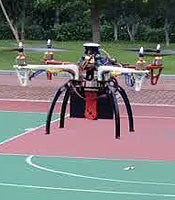
Reading CO2 and oxygen levels in remote areas can be challenging. That's why we were excited to see CO2Meter’s S8 CO2 sensor and UV Flux oxygen sensor installed on a drone for high-altitude atmospheric testing.
The project is the brainchild of RYF Technologies. Last year, they began testing CO2 sensors to create a handheld CO2 monitor for the Chilean market. A requirement for the new monitor was that it used a built-in barometric sensor to automatically adjust the CO2 level for extreme changes in altitude in the Andes Mountains. The monitor uses a built-in micro pump to quickly change the air around the sensor and improve response time as measurements are taken.
Once the prototype was complete, RYF decided to change to our low-power S8 CO2 Sensor. The S8 is one of the smallest non-dispersive infrared (NDIR) sensors on the market, and is able to measure CO2 levels up to 5% in a very small and low-power package.
In addition to measuring CO2, the monitor was upgraded to measure oxygen using our UVFlux Oxygen Sensor. This low-power sensor is specifically designed for battery powered applications. Temperature and relative humidity sensors were also installed.
The final step in the project was to install the complete package in an off the shelf drone. In field testing, the package has been successfully proven to record CO2, oxygen, temperature, humidity and barometric pressure in real time up to 500 meters (1,640 feet) from the controller. This will make the new drone useful for scientific environmental analysis and studies in cities, fires, volcanos, factory chimneys, or anywhere not easily accessible for field air quality testing.
All sensor data is collected, processed and stored using custom software developed and prototyped on an Arduino microprocessor.
The completed drone package is still a prototype. New case designs are being created and tested at RYF Technologies using their in-house 3D printer.
For more information on this project, visit the RYF Technologies page.







